Asus ProArt Display OLED PA32DC review: The new OLED standard
Expert’s Rating
Pros
- The best SDR image quality yet
- Good HDR performance
- Long list of image quality features
- Exceptionally sturdy
- Numerous inputs, plus USB hub
Cons
- HDR brightness could be better
- Glare can be an issue in bright rooms
- Only 60Hz, no adaptive sync
Our Verdict
The Asus ProArt Display OLED PA32DC has the best SDR image quality we have ever seen. It feels sturdy and well built with a range of ergonomic adjustment options. While the price will put this out of reach for most people, those who can afford it will be rewarded with a top-of-the-line display. Put simply, it’s an outstanding choice for professionals and content creators.
Price When Reviewed
3,499
Best Prices Today: Asus ProArt OLED PA32DC
The rollout of OLED monitors continues to be a hesitant, stutter-stop affair. The Alienware AW3423DW’s arrival in early 2022 seemed to herald a new wave of options but, for most people, OLED remains an extravagant expense.
The Asus ProArt Display OLED PA32DC unfortunately does little to make OLED more affordable, but it does raise the bar on image quality in a big way.
Note: This review is part of our ongoing roundup of the best monitors. Go there to learn more about the competition, what to look for in a monitor, and buying recommendations.
Asus ProArt Display OLED PA32DC: The specs
The Asus ProArt Display OLED PA32DC is, in many respects, a rather conventional professional monitor. It has a 32-inch display, 4K resolution, a 60Hz refresh rate, and supports HDR.
- Display size: 32-inch widescreen
- Native resolution: 3840×2160
- Panel type: 10-bit OLED
- Refresh rate: 60Hz
- HDR: Yes, HDR10, HLG, VESA DisplayHDR 400 True Black
- Ports: USB-C with 65W Power Delivery, 4x USB-A 3.2 Gen 2, DisplayPort 1.4, 3x HDMI 2.0, 3.5mm audio-out
- Stand adjustment: Height, tilt, swivel, pivot
- VESA mount: 100x100mm
- Speakers: Yes
- Price: $3,499
So, what are you paying for? The OLED panel. Its presence seriously elevates the experience of using the monitor in both SDR and HDR. Asus also throws in a few extras, like a USB hub and tons of video inputs (five in total). Still, this is an expensive option even among 32-inch 4K monitors—but the expense is justified by performance.
Asus ProArt Display OLED PA32DC: Design
The Asus ProArt Display OLED PA32DC is an absolute unit. Unlike most modern monitors, which use slim bezels to minimize size, the PA32DC’s large bezels look chunky and old-school.
The monitor is fairly slim in profile, measuring no more than two inches thick at its thickest point and about an inch towards the edges, but the heatsink-like rear panel comes across as ruggedized rather than svelte.
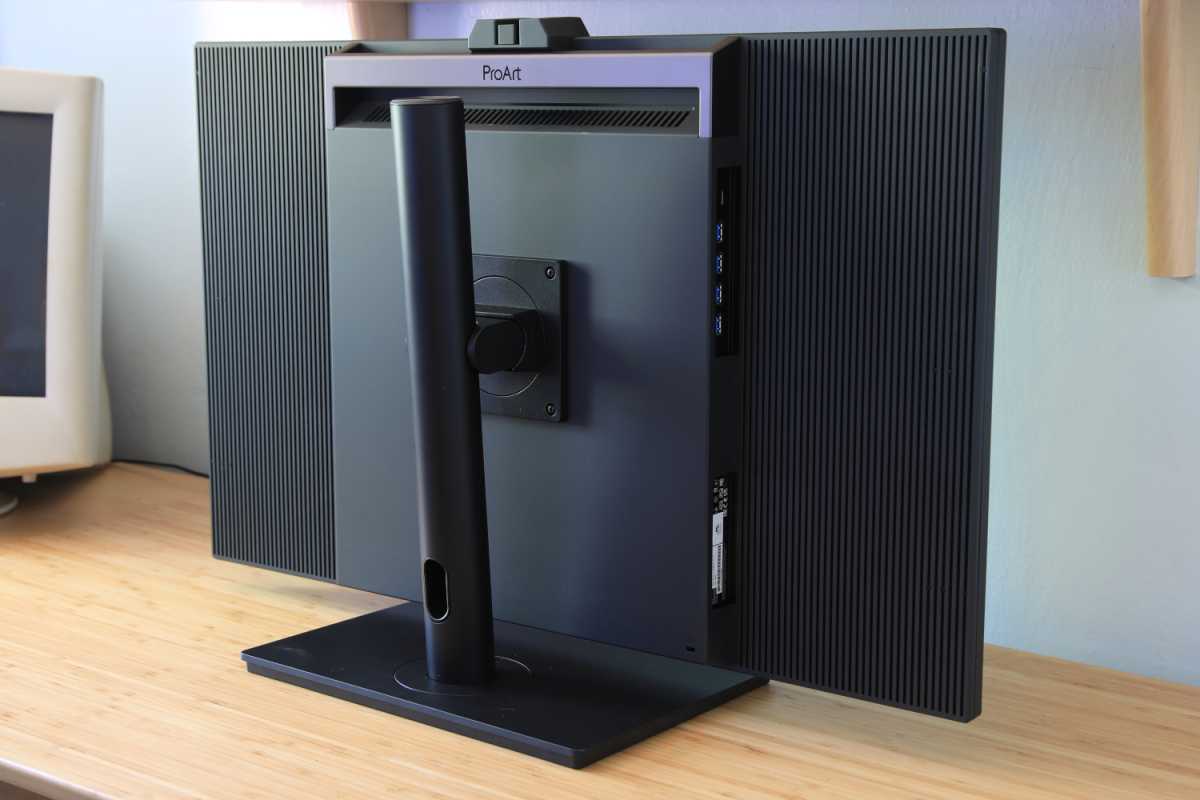
The Asus ProArt OLED PA32DC is one solid display with a thick heatsink on the rear.
Matt Smith
Build quality is easily the best of any monitor I’ve tested in recent memory. The rear panel and bezels feel durable and allow little to no flex when handled. It’s not a luxurious monitor, but its rigidity and functional aesthetic make its quality obvious.
I suspect the monitor could take the occasional bump in stride (so long as the display panel is protected), but a built-in handle makes accidents less likely. The handle is firmly attached to the chassis and supports the monitor’s 16-pound weight (without stand).
Put simply, the Asus ProArt Display OLED PA32DC is as close to perfect as any monitor I’ve tested.
The handle isn’t just for show, as Asus clearly believes some owners will move the display. The monitor’s pair of flip-out base legs, which are installed by default, aid in its portability. These legs can be rotated to provide a base for the display, then rotated back below the bottom bezel when it’s time to move the monitor.
An ergonomic stand is also included. It attaches to the monitor’s 100x100mm VESA mount via four screws: The stand mount doesn’t have a quick-release system, as is common on consumer displays. The stand looks simple but provides the usual range of adjustments including height, tilt, swivel, and pivot.
Asus ProArt Display OLED PA32DC: Features and menu
The PA32DC doesn’t skimp on connectivity. It includes three HDMI 2.0 ports, one DisplayPort, and one USB-C port with DisplayPort Alternate Mode. That’s a total of five video inputs, an exceptional number for any modern monitor.
USB connectivity is also good, though not great. The monitor’s USB-C port acts as a USB hub for four additional USB-A 3.2 Gen 2 ports. It’s great to see this many USB-A ports supported, and even better that they offer a strong version of the USB 3.2 spec instead of falling back to USB 3.0 or a mix of USB 3.0 and USB 2.0.
There’s no Ethernet, however, or video-out for daisy-chaining additional displays. The monitor also lacks additional USB-C ports, and the USB-C port only provides 65 watts of Power Delivery. That’s not enough power to charge many high-end laptops under load.
Both the video inputs and USB ports are easy to access, as they’re oriented towards the sides of the monitor instead of the rear and aren’t obstructed by the chassis. That’s good news if you frequently connect and disconnect devices.
The PG32DC’s on-screen menu, which is controlled by a joystick and buttons on the front right bezel, provide a long list of options that few monitors can match. Preset display modes include support for sRGB, AdobeRGB, Rec. 2020, DCI-P3, DICOM, and Rec. 709, plus HDR modes for Rec. 2020, HDR LHG, and HDR DCI.
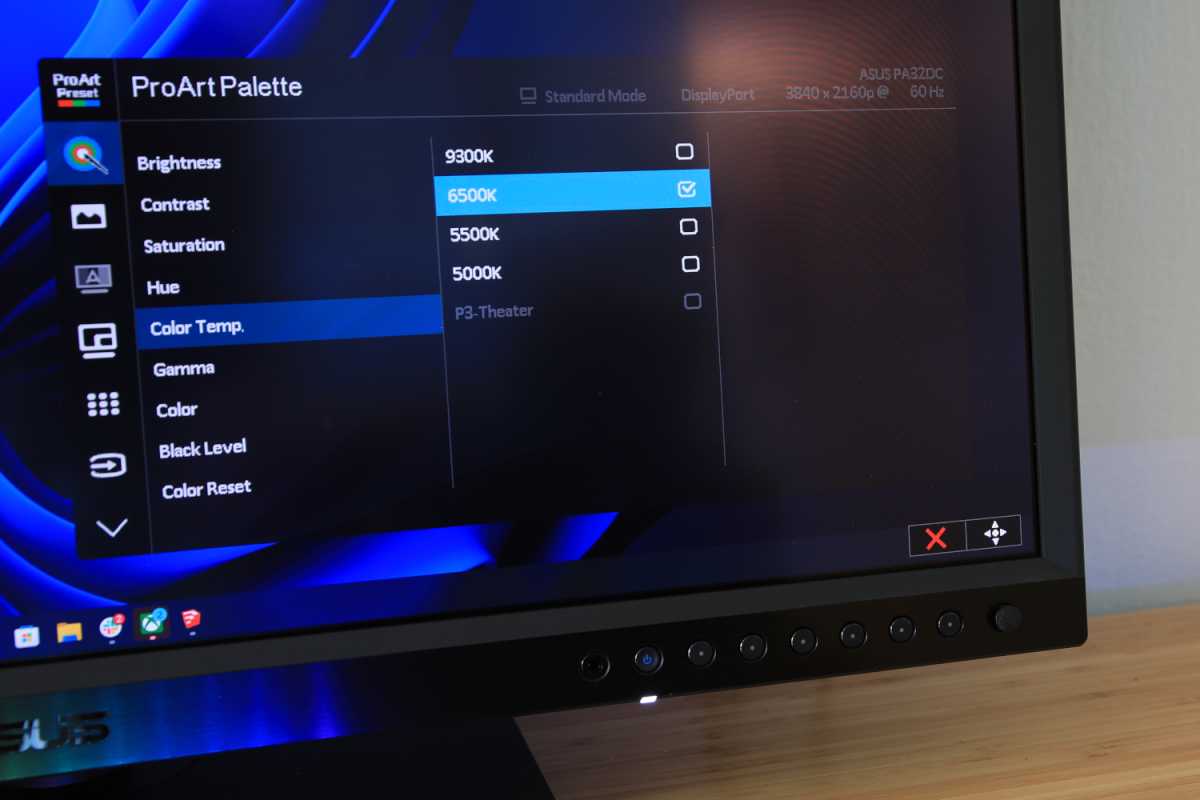
Asus ProArt OLED PA32DC’s menu comes with a range of adjustment options.
Matt Smith
Adjustments are equally robust, spanning four color temperature modes and five gamma presets. There’s also six-axis color hue and saturation adjustment, plus gain, offset, and black level control.
These controls are way beyond what even a typical enthusiast will need, but provide professional users the chance to fine-tune the monitor to achieve a specific standard of quality.
The monitor even provides a calibration utility that can be used in tandem with a variety of third-party color calibration tools, including the Datacolor SpyderX and Datacolor X-Rite, to hone color accuracy and brightness to exacting standards. This utility, which includes a hardware calibration tool that rotates into position at the top of the display, was successful in calibrating the display to a level of color accuracy few monitors can rival.
A pair of built-in speakers round out the PG32DC’s long list of features, but they’re quiet and don’t sound great in most situations. They’ll work in a pinch, but external speakers or headphones are preferable.
Asus ProArt Display OLED PA32DC: SDR image quality
Image quality is important for any monitor, but it’s critical for the PA32DC. Excellent image quality is the entire point. Fortunately for Asus, the PA32DC delivers across the board.
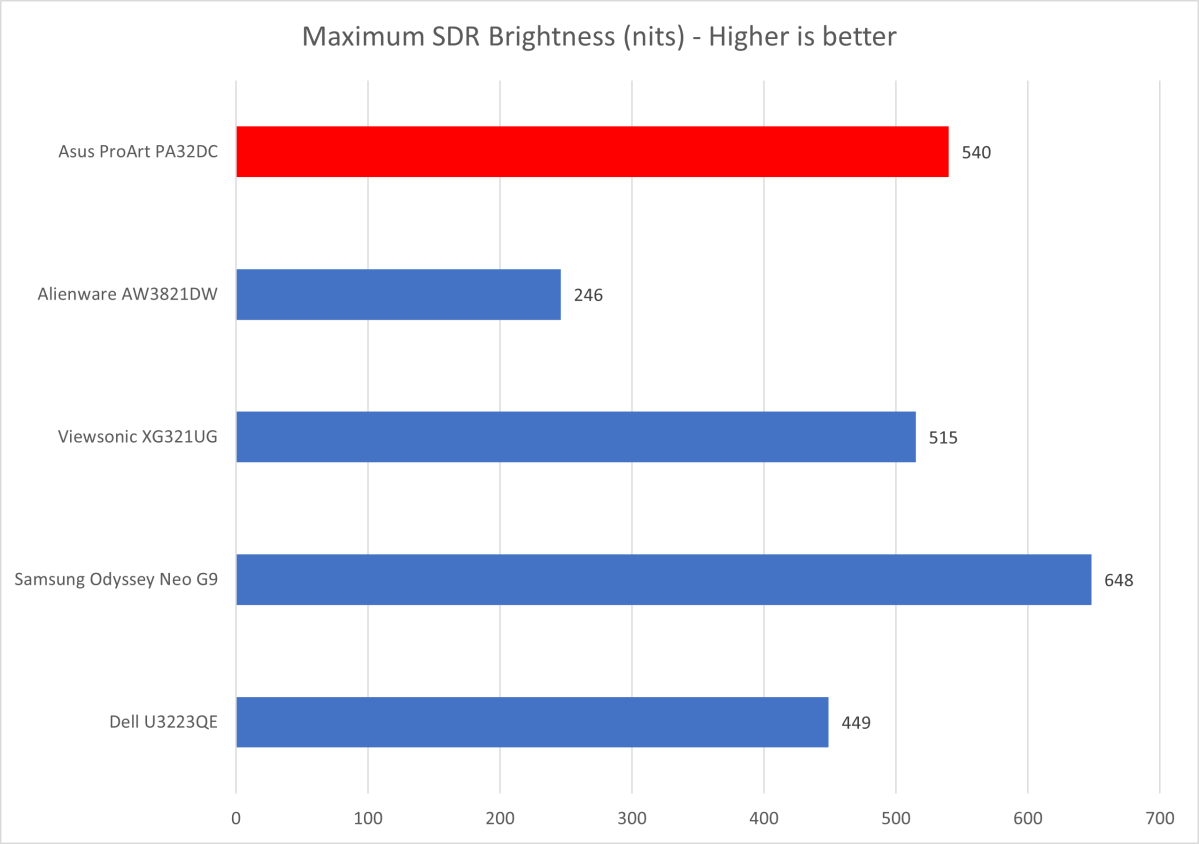
Matt Smith
Maximum SDR brightness comes in at 540 nits. It should be noted this level of brightness is lower when displaying a large, bright image for more than a couple seconds, a situation I’ll explain more in this review’s HDR section. Still, the monitor’s brightness is acceptable.
However, the display’s usability in a bright room takes a hit due to the semi-gloss display panel. It’s not as reflective as Apple’s Pro Display XDR but will suffer whenever a light source reflects across its surface. This makes the monitor harder to use in a brightly lit room.

Matt Smith
Contrast is excellent, with a measured maximum contrast ratio of 37,010:1. That’s roughly 37 times higher than a typical IPS monitor. It also beats Mini-LED alternatives like the Viewsonic XG321UG, Asus PG32UQX, and Samsung Odyssey Neo G9.
The Alienware AW3423DW scores better here, as it registered pure black (that is, a brightness level of zero nits) in testing, while the Asus PG32DC showed brightness level of 0.1 nits in pure black. This is a trivial difference in real-world use, however, and both displays offer excellent contrast performance.
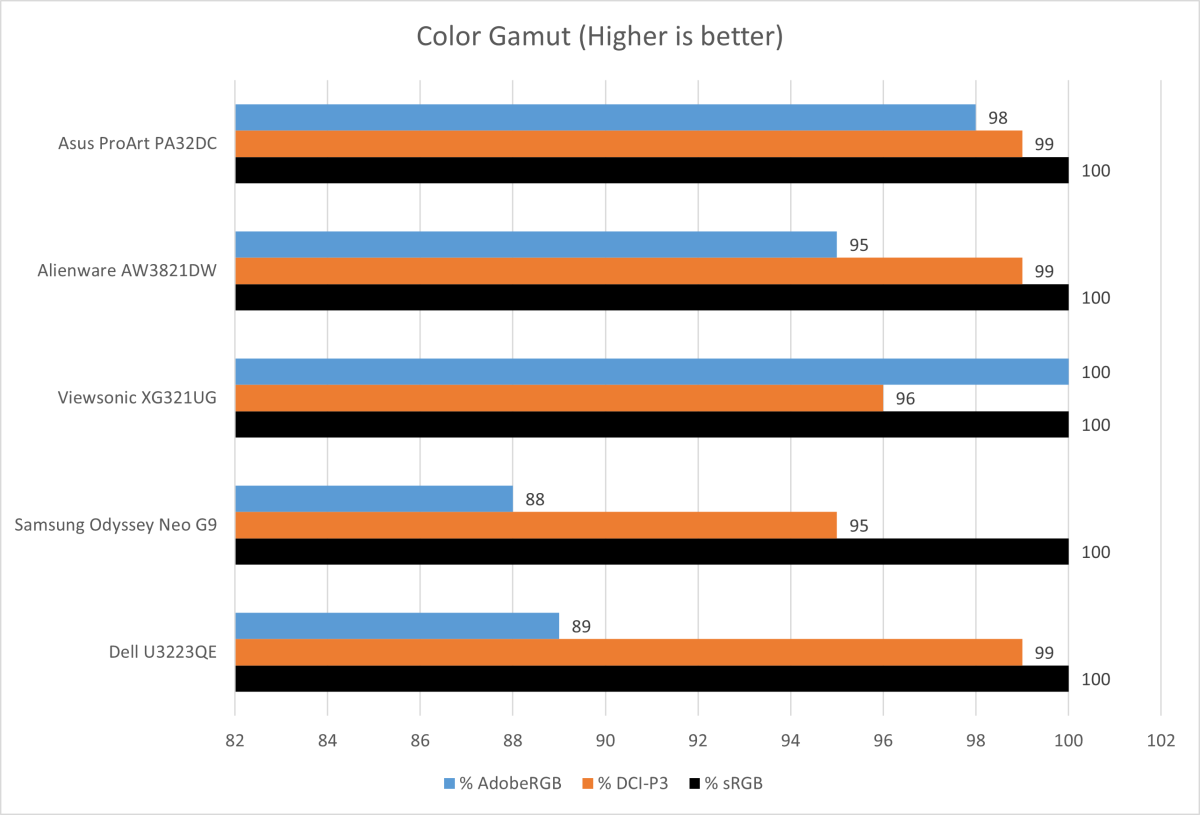
Matt Smith
The PG32DC knocks color gamut out of the park, achieving 100 percent of sRGB, 99 percent of DCI-P3, and 98 percent of AdobeRGB. This is technically better than the Alienware AW3423DW, which was more limited in AdobeRGB, and among the elite echelons of all monitors I’ve ever tested.
This level of color gamut performance means the PG32DC can display an extremely wide range of color. That’s useful in professional settings, where creators want to make sure they can see every color present in the content they’re creating, but it’s also nice in general use as it leads to a more saturated and vivid look.
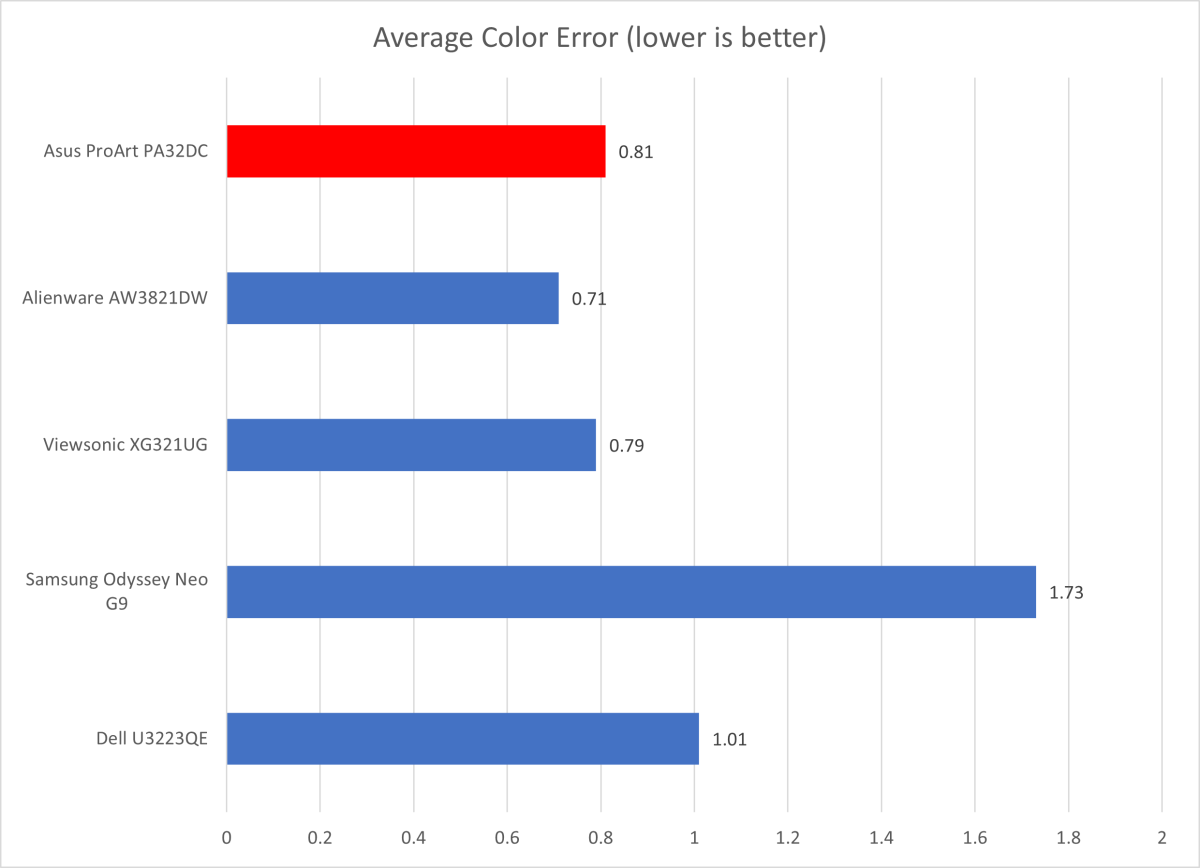
Matt Smith
Color accuracy is excellent out of the box. It’s not the best I’ve tested, but today’s best monitors are superb in general use, so the differences between them have less impact. This level of color accuracy is more than enough to provide a lifelike and realistic look.
As mentioned, the monitor includes a built-in calibration utility and hardware that’s meant to achieve precise results. I tried it and found it lowered color accuracy even further, as noted on the graph. The result still isn’t the absolute best I’ve recorded, but should still be far more than accurate enough for any professional use.
The PG32DC also did well in color temperature and gamma, achieving the target color temperature of 6500K and gamma curve of 2.2 straight out of the box. I also tried the additional color-temperature and gamma options and found they, too, were accurate to what they promised.
This monitor uses a conventional RGB subpixel layout similar to a typical IPS monitor. This is important, as many OLED displays, including the Alienware AW3423DW (and, presumably, any future monitors based on the same QD-OLED technology) use an alternative layout that can lead to color fringing or odd stagger-step patterns around fine details, including fonts. This is a major vote in favor of the PG32DC’s sharpness and day-to-day usability, as it suffers no such issues. Small fonts are readable and every bit as sharp as an IPS monitor like the Dell U3223QE.
Put simply, the Asus ProArt Display OLED PA32DC is as close to perfect as any monitor I’ve tested. Is it flawless? Well…not exactly, but it’s close. Though not technically perfect in every way, the monitor’s SDR performance has no obvious weak point.
My sole nitpick is the semi-gloss finish which, combined with modest brightness in some use cases, can be an issue—but it’s nothing a pair of curtains can’t fix.
Asus ProArt Display OLED PA32DC: HDR image quality
The Asus ProArt Display OLED PA32DC is HDR compatible and carries VESA DisplayHDR 400 True Black certification. This is a level of certification available to OLED displays that indicates their ability to reach low black levels. It’s also the lowest level of True Black certification available from VESA—which, given the PA32DC’s price, is a disappointment.
In testing, the PA32DC was capable of decent HDR brightness depending on the situation. It was only able to achieve a full-screen maximum of 302 nits, but that was increased to 502 nits when only half the screen was brightly lit, and up to 552 nits with 10 percent of the screen brightly lit.
This variance in brightness can be seen in use, but it’s only obvious when a small, bright area gradually expands (or vice versa). This is an advantage over the Alienware AW3423DW, which, in some situations, can suffer dramatic swings in brightness that are overly distracting.
Still, the PA32DC’s HDR performance leans more on its contrast and color performance than its brightness, and that has consequences for content. It’s best when displaying dark, moody content, which showcases the monitor’s ability to provide detail. And, of course, a good starfield view works wonders, as each star appears brilliant against the inky darkness of space.
Brighter content still looks good, but the lack of sustained brightness is a limitation in some situations. When playing Microsoft Flight Simulator, for instance, I noticed the brilliant flare of a sunset was never quite as dramatic as on a Mini-LED alternative. The same can be said of snowy fields in a movie or streaming show filmed for HDR.
Don’t get me wrong: The PG32DC is still at least a good HDR monitor and among the best choices for HDR content. I’d rank it higher than the Alienware AW3423DW thanks to the PG32DC’s less obvious swings in brightness. It sustains higher brightness than the Alienware overall, and in all situations.
The PG32DC is also leagues better than a premium professional monitor that lacks good (or any) HDR support. If you’re thinking about an upgrade from a BenQ PD3200U, Dell Ultrasharp U3221Q, or Asus ProArt 329CV, you’re going to be floored by the improvement.
Asus ProArt Display OLED PA32DC: Motion clarity
The PA32DC is not sold as a gaming monitor and makes no promises about game performance. It has a 60Hz refresh rate and doesn’t support any adaptive sync standard—not even FreeSync.
Game performance is lackluster. The OLED panel offers good motion clarity for a 60Hz display, but that doesn’t make up for the absence of a high refresh rate or adaptive sync. Moving objects look soft and it’s often difficult to pick out fine detail when panning a camera quickly in a 3D game.
That’s not to say it’s hopeless. I had a perfectly enjoyable experience in Microsoft Flight Simulator, Old World, and Final Fantasy XIV. None of these games lean heavily on motion clarity or smoothness.

The Asus ProArt OLED PA32DC running Microsoft Flight Simulator.
Matt Smith
However, most players will be far more pleased by the Alienware AW3432DW, Viewsonic XG321UG, or Asus PG32UQX, all of which pair solid HDR performance with high refresh rates and adaptive sync.
Final thoughts
Asus’ ProArt Display OLED PA32DC is the best monitor I’ve ever tested—in SDR image quality, at the least, and in general build quality and function, as well. Prosumers who want a fantastic monitor, and are willing to pay to get it, will be thrilled. Professionals will love the monitor’s excellent color performance, high contrast, numerous inputs, and long list of image quality features.
That’s not to say it’s the perfect monitor for every person. The $3,000 price tag alone will take it out of contention for most people, myself included. Add the monitor’s lack of adaptive sync, modest refresh rate, and large size, and the result is a monitor with specific appeal.
But if you’re in the target market, and have the cash to spend, the PA32DC is an outstanding choice. I suspect this monitor’s most serious problem will be availability: Everyone craving OLED is going to want one.
For all the latest Technology News Click Here
For the latest news and updates, follow us on Google News.
